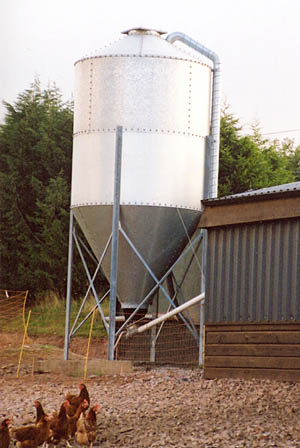
Many types of bacteria are present in the gut of animals and in most cases a symbiotic relationship exists where the type and numbers of bacteria are in balance with the host. Some animals, notably ruminants, depend upon gut bacteria to assist with digestion. If an imbalance between the host and the number of pathogenic bacteria occurs, a disease state will exist. In laying hens it is in the birds and our interest to maintain this balance and one way of trying to achieve this is with the use of organic acids.
Many long chain fatty acids will be familiar - lineoleic, butryic, acetic and formic acids, and these occur naturally. We are all familiar with the use of acetic acid (vinegar) to preserve many food items and it is the butryic acid in butter that confers preservative properties while another, formic acid, is used to inoculate silage to reduce the risk of clostridial infections. High concentrations of acid and thus a low pH will depress bacterial growth and this is used to control a number of pathogens such as E. coli, Salmonella and Campylobacter species.
Formic acid in the form of it’s salt, calcium formate, can be added to poultry feed quite safely since it has a neutral pH and there is no danger of a reaction with other ingredients which are sensitive to acidity such as vitamins and yolk pigments. However, calcium formate is not effective in a dry environment and is activated when it reaches the bird’s crop where the temperature and moisture content rise. The acid salt dissociates to the acid, which is bactericidal for certain types of bacteria. This is important since in a warm moist environment bacteria that were formerly dormant, for example in the dry feed, will start to replicate. Should feed become damp during storage, the acid salt will dissociate in the presence of the moisture into formic acid and exert a degree of control over any bacterial contamination. The precise mechanism by which the formic acid exerts its bactericidal action is not clear but it is known to cross the cell wall and interfere with cell metabolism and DNA replication resulting in cell destruction. In this way formic acid can help to control certain bacterial infections both in the hen and in the feed.
Calcium formate can be used during all stages of a hen’s life from egg production on the breeding farm to egg production in the laying unit. The salt is mixed with the feed at the mill at a rate of between 2kg to 4kg per tonne but up to 7kg per tonne can be used if contamination is suspected.
Calcium formate is not a treatment for pathogenic bacteria. If a bacterial challenge occurs, veterinary assistance should be sought and the flock treated under veterinary supervision. Once the problem has been treated successfully, addition of calcium formate to the feed may help to help prevent a re-challenge and horizontal spread of infection within the flock.
One BFREPA member reported a major problem in one flock in birds only 30 weeks old. The cause of death was confirmed as E. coli infection, which, as the Vet reported in last months Ranger, is an increasing problem with free range birds. The flock was treated accordingly and since then calcium formate has been added to all feed in an effort to prevent a re-occurrence of the problem, reportedly with some success. It is the member’s firm belief that since bacterial counts in the litter in free range flocks can be very high, it is our duty to take every measure to prevent these types of infection. The cost of adding an acid salt to the feed is about £3 per tonne and is justified as insurance for a healthy flock. This may seem to be a ’belt and braces’ approach but may be a small price to pay in the effort to improve biosecurity in our flocks.
